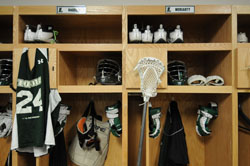$62M athletic complex includes new fields, locker rooms
Posted: 7:00 pm Sun, March 14, 2010
By Liz Farmer
Daily Record Business Writer
 After more than a decade of planning, fundraising and construction, Loyola University Maryland is counting on its new $62 million Ridley Athletic Complex to impress recruits and boost the school’s image.
After more than a decade of planning, fundraising and construction, Loyola University Maryland is counting on its new $62 million Ridley Athletic Complex to impress recruits and boost the school’s image.
“It engenders pride,” said The Rev. Brian F. Linnane, Loyola’s president. “We feel that … done in the right way, it will give us great momentum internally with our students and faculty, and externally it will attract more students and alumni.”
And in going from one 4-acre field on campus to a 71-acre sports complex that eventually will have two fields and a running track, Loyola’s athletics facilities have definitely been supersized.
J. Richard Awalt Field will host soccer and lacrosse games and the adjacent Sean Lugano Memorial Field will be used for practices and rugby games. Both of those facilities are completed. Construction on the 400-meter track is scheduled to begin soon at the complex, which is about three miles from Loyola’s Evergreen Street campus.
Awalt Field seats 6,000 — roughly 1,000 more than Diane Geppi-Aikens Field on campus — and on a clear day visitors can see the Francis Scott Key Bridge from the top of the stands. The new building includes a presidential suite, tailgating concourse, reception rooms overlooking the field and a room for film review and postgame news conferences.
“We had a converted racquetball court for film sessions … and the press conference room varied. We basically had nothing,” said Joseph Boylan, Loyola’s athletic director. “This is the way it should be.”
The men’s and women’s lacrosse and soccer teams all now have their own locker rooms — complete with flat screen televisions. Previously, the men’s teams shared one locker room as did the women’s teams. The complex also houses a visitor’s locker room and training and weight rooms that are both more than twice the size of their predecessors.
Loyola is hoping the facilities will help lure athletes.
“You’re talking about 17-year-old recruits, so you want to have something that’s kind of ‘Wow, that’s great — that’s Loyola,’” said Boylan.
The complex hosted its first games last week, including a scheduled “grand opening” event featuring a men’s lacrosse match against Duke on Saturday. But the idea for a new athletics facility was hatched in 1998 under former Loyola President Harold Ridley. After years of planning, fundraising, prepping the former landfill site and four years of construction, the facility was a labor of love for many.
“We’re talking about ‘strong truths well lived’ — I think this sums it all up,” said Boylan, quoting Loyola’s motto, which is emblazoned on a wall in the entryway to the new athletics department offices now located at the complex. “Developing leaders for the 21st century to help the world for the better is part of the university’s mission, and I think athletics is part of that.”
Linnane said the complex is a key part of the university’s goal, outlined in its 2007 strategic plan, to expand its educational programs and become the leading comprehensive Catholic institution in the country.
“That’s measured in student experience, undergraduate and graduate,” said Linnane. “It’s really not about an external rating, but we’ve developed markers for how students can be best served in preparation for the 21st century.”
Founded in 1852 as a Jesuit liberal arts college, Loyola has added two doctoral programs and more than 30 masters degrees over the past 50 years. As part of shedding its small college image, the school changed its name from Loyola College in Maryland to Loyola University Maryland and launched its School of Education last fall.
Linnane also noted the new complex frees up space on campus occupied by Diane Geppi-Aikens Field for possible future development. The strategic plan calls for about four academic buildings to be built there, but with the high demand from recreational and intramural sports for fields, Linnane said that development was still years away.
“Someday there will be buildings there I suspect, but probably not while I’m still president,” he said.
Click here to access rest of story on TDR.